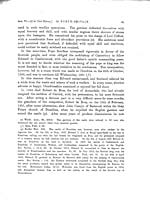Volume 5
(88) Page 82
Download files
Individual page:
Thumbnail gallery: Grid view | List view

82 earl of Carrick, to receive to his allegiance and grace, the people, both English and Scottish, who inhabited Annandale and the adjacent parts (y). But enforced submission could not long endure; and in December 1297, Lord Clifford made an irruption from Carlisle into Dumfriesshire, when he wasted the country and slew many people (z). In July 1298, Edward took possession of Lochmaben castle, the ancient seat of the Bruses. In 1299 and 1300, John de St. John acted under the English king as keeper of Nithsdale and Annan- dale, as far as the limits of Roxhurghshire (a); but St. John seems not to have enforced complete submission, whatever may have been the numbers or appoint- ments of his troops (6). In the summer of 1300 A.D., Edward assembled a large army at Carlisle, for the subduction of Dumfriesshire and the invasion of Galloway. The English army now marched forward into Dumfriesshire, wasting the country as they advanced, according to the usual practice of an unfeeling age. Edward now strengthened the castles of Lochmaben and of Dumfries, wherein he placed adequate garrisons with ample supplies, with a governor for each; and he erected a large (c) Peel of wood at Dumfries, thinking that he could not make that frontier town too secure (d). The great effort of Edward's arms in this vigorous campaign, was the siege of Caerlaverock castle, which occupied his army and his art for a considerable time, with his artizans and engines, as far as they were then known, and (y) Rym. F�d., ii. 714. (z) Bord. Hist, 208. (a) Rym. F�d., ii. (b) Among other forces, St. John had with him a knight banneret, who was allowed 4$. a day ; six knights, who were allowed 2s. a day ; thirty esquires, who had 1s. a day ; and he was given 51. 3s. 6d. a day for 40 caparisoned horses. He had other knights and soldiers under his authority. Wardrobe Acco. of Edward I., 138-9, 141. Such were the military manners of that warlike age and king! (c) In June 1300, Edward came to Dumfries, where he lodged for several days in the house of the minor friars, to whom he made a small allowance for his accommodation. Wardr. Acco., 41. He returned to Carlisle, where he joined his army, which moved upon Dumfriesshire on the 24th and 26th of June. From the 6th to the 16th of July, Edward was at Applegarth, Tinwald, Dumfries, and Caerlaverock, and he made many oblations at the altars of the churches, to propitiate success in the capture of Caerlaverock castle, which seems to have surrendered on the 16th of July. On the morrow, Edward advanced into Galloway, where he continued with his army about six weeks. He returned at the end of August to Caerlaverock, whence he soon after went to Holm Cultram, while a large body of his army returned through Dumfriesshire to Carlisle, marking their course by their devastation. Another part of his army returned to Carlisle at the end of October 1300. Mean- while Edward returned from Carlisle on the 16th of October to Dumfries ; where with his queen and court, he continued till the beginning of November. Wardr. Acco., 41-2-3 ; 215, 226-7, 230. (d) Ib., 74, 81-2, 120-127, 142.
Set display mode to:
![]() Universal Viewer |
Universal Viewer | ![]() Mirador |
Large image | Transcription
Mirador |
Large image | Transcription
Images and transcriptions on this page, including medium image downloads, may be used under the Creative Commons Attribution 4.0 International Licence unless otherwise stated. ![]()
| Caledonia, or, An account, historical and topographic of North Britain from the most ancient to the present times > Volume 5 > (88) Page 82 |
|---|
| Permanent URL | https://digital.nls.uk/74530300 |
|---|---|
| Description | Vol. V. |
|---|---|
| Attribution and copyright: |
|

